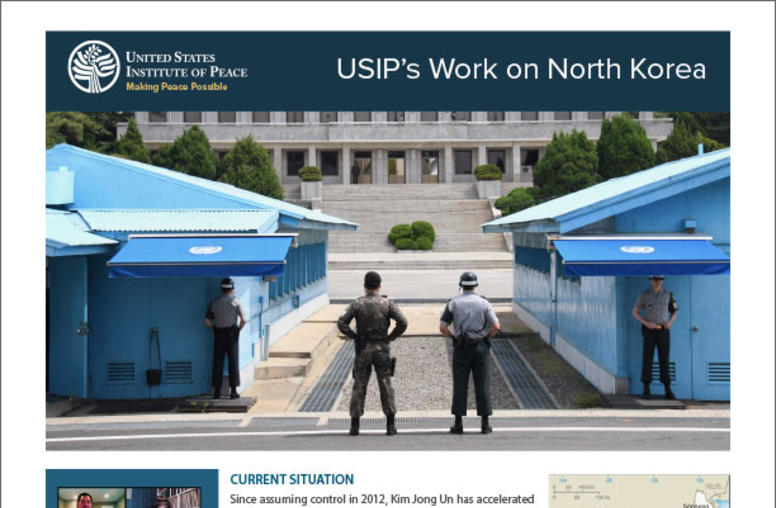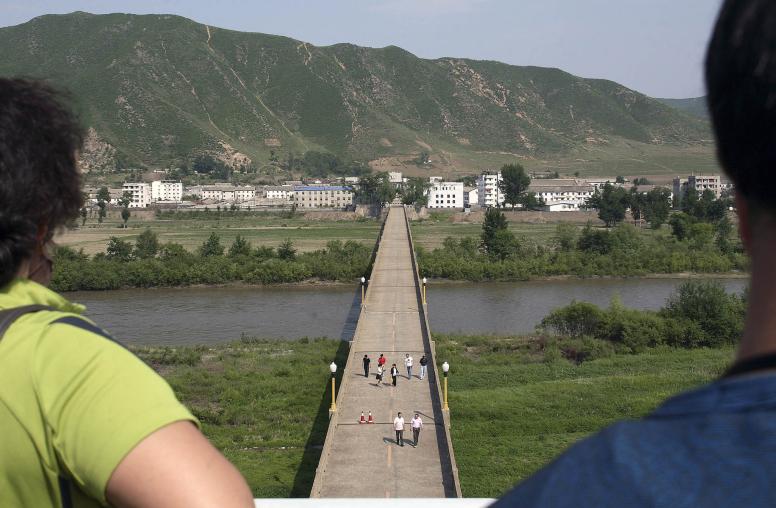North Korea Blew Up Its Liaison Office with the South. What Now?
Expect more low-level provocations from Pyongyang and limited attention from China, USIP analysts say.
North Korea’s demolition this week of an inter-Korean liaison office that symbolized North-South cooperation marks a new spike in tensions between the countries, and in North Korean frustration with the United States. It was the latest in a string of inflammatory rhetoric and actions directed at Seoul and Washington since the failure of the February 2019 summit in Hanoi between President Trump and North Korean leader Kim Jong Un. The building’s demolition renews strains over North Korea’s ongoing development of a nuclear weapons arsenal, the corresponding global sanctions against Pyongyang’s illicit behavior and the 67-year failure to formalize a peace treaty following the Korean War. USIP analysts Patricia Kim and Frank Aum discuss the latest downturn.

North Korea used explosives to destroy a liaison office that it built with South Korea just two years ago. What does this mean?
Aum: This office building in Kaesong, a North Korean city near the border, formally opened only 21 months ago as a place to discuss joint economic projects and other matters that could advance inter-Korean relations. The building itself was a dramatic symbol, adorned on its front with a map of a unified Korean Peninsula. And so its destruction was a dramatic demonstration as well, meant to escalate tensions and increase pressure on South Korea and the United States. It’s part of a pattern of North Korean actions over the last year meant to signal the regime’s frustration with U.S. unwillingness to provide sanctions relief and South Korea’s inability to challenge U.S. policy. Pyongyang has escalated tensions sharply during the last two weeks, but it has also steadily indicated its displeasure with Seoul since the February 2019 Hanoi summit failure, including criticizing the U.S.-ROK [South Korea] joint military exercises, condemning South Korea’s taking possession of U.S.-built F-35 and Global Hawk aircraft, and threatening to dismantle South Korean-built facilities at the joint Mt. Kumgang tourism site.
Kim: North Korea’s behavior clearly demonstrates that Pyongyang sees little value in keeping the door open for diplomacy in the near term. There are multiple intended audiences and objectives behind North Korea’s new round of escalatory actions. These include pressuring South Korea to offer more concessions and raising tensions in the region in order to increase its bargaining power in future negotiations. Pyongyang’s actions are also designed to signal to the North Korean people that South Korea and the United States, not their dear leader, are to blame for the lack of progress in diplomatic negotiations.
While spurning Seoul and Washington, Pyongyang has been openly courting Beijing in recent weeks. It has gone out of its way to publicly express confidence in China's handling of the COVID-19 pandemic and its moves in Hong Kong. Such behavior is unsurprising given North Korea's dependence on China for trade, which has shrunk in recent months due to the tightening of the countries’ border following the COVID-19 outbreak.
What should we expect next, then?
Aum: North Korea will continue to use lower-level provocations and inflammatory remarks to increase pressure on Washington and Seoul in the areas it senses will hurt the most. In the case of South Korea, the administration of President Moon Jae-in has been politically invested in inter-Korean cooperation. So we can expect North Korea to take additional steps to undermine the gains from inter-Korean diplomacy in 2018, including voiding the April 2018 Panmunjom declaration and the September 2018 comprehensive military agreement, rebuilding guard posts and remilitarizing the DMZ, and resuming military drills near the Northwest Islands. To pressure the United States, which is focused on denuclearization, Pyongyang may conduct short- to medium-range missile tests or even satellite launches, and continue expanding nuclear and missile facilities. We also could see cyberattacks or other actions that are harder to attribute but that will be designed to keep things uncomfortable for the United States and South Korea.
All of this said, it’s not likely that North Korea will resort to a major provocation, such as a nuclear or ICBM [intercontinental ballistic missile] test, in the near future. That’s because it wants to avoid significant retaliation from the United States and the international community—notably additional sanctions. And it would not want to risk a withdrawal of humanitarian and economic assistance by China.
Kim: Beijing's reaction to North Korea’s recent antics has been largely muted. While China remains invested in the stability of the Korean Peninsula and ultimately seeks a diplomatic solution to the North Korean nuclear issue, China is preoccupied, to say the least, with controlling new outbreaks of COVID-19 at home, mitigating the economic damage of the pandemic, managing a crisis along the Sino-Indian border, and addressing growing bilateral competition with the United States. North Korea, as such, will likely remain a back-burner issue for Chinese leaders, short of a major crisis on the Korean Peninsula.
Then what does all of this suggest for U.S. and other policymakers?
Aum: Since Washington and Seoul are unlikely to significantly amend their approaches to North Korea in the next several months, they will more likely focus on things like avoiding overreaction to North Korea’s outbursts, messaging alliance resolve and solidarity, increasing financial costs to the North Korean regime, and strengthening military deterrence and readiness. They should also address current thorns in the alliance, such as the current impasse over how to share costs for U.S. troops stationed in South Korea and the ongoing historical and trade disputes between South Korea and Japan.
Kim: Given the current state of U.S.-China relations, which arguably are at their lowest point in decades, it seems unlikely that Washington and Beijing will be able come together to coordinate strategies and insert fresh energy into diplomacy with North Korea in the near term. Peace on the Korean Peninsula, however, remains a fundamentally shared interest among all of the major stakeholders in the region, including the United States and China. Leaders in Washington and Beijing, therefore, should work to prevent bilateral competition in other domains from undermining pragmatic bilateral and multilateral cooperation on the Korean Peninsula.



